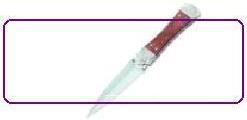You may have noticed that the United States is not issuing colour terrorist alerts with as much frequency or enthusiasm as it used to. Optimists may see this as evidence that the Bush administration’s war on terror is actually effectively blocking new attacks. Pessimists may see this as evidence that the terror alerts were a transparent ploy to keep the American people docile by manipulating their fear. Optimists may argue that pessimists don’t take the threat of terrorist action seriously. Pessimists may belligerently tell optimists that they’d be happy to take the discussion outside if the optimists think they’re man enough. Optimists may respond: You wanna be startin’ something? Better not be startin’ something. I’m good to go right here! Much metaphorical bloodshed may ensue.
Me, I’m a glass half full of gelignite kind of guy.
Although it has run its course in terms of terrorism, I can’t help but think that the colour coding system can be adapted for a variety of other worthwhile purposes. I would like to suggest one: tracking the way the Bush administration uses rhetorical devices. It would be simple enough: when a Bush administration official makes a pronouncement, a colour coded rhetoric alert would be issued classifying the level of rhetoric based on the following taxonomy:

LEVEL ONE: CODE ORANGE: stonewalling. This alert occurs when an administration official refuses to answer a direct question directly. In extreme cases, the administration will begin an investigation into an issue, or even make use of investigations initiated by other parties (ie: pesky attorneys-general), giving it the option of arguing: “I cannot comment while that is under investigation/the grand jury is still deliberating/the trial is proceeding.” Used properly, an investigation can allow the government to stonewall for years.

LEVEL TWO: CODE BLUE: denial. This alert occurs when an administration official denies a fact which, to everybody else in the world, seems uncontrovertibly true. An example is the administration’s continued denial that the insurgency in Iraq is an ongoing problem that is not being subdued. Phrases such as “We have turned a corner in the war in Iraq,” “The insurgency is in its last throes” and “The fact that insurgent attacks are increasing is evidence that our enemies are getting desperate and that we are winning the war” are strong indicators that rhetorical denial is in full effect.

LEVEL THREE: CODE RED: befogging the issue. This alert occurs when an administration official responds to a question about an issue with something irrelevant to the issue. Defense Secretary Donald Rumsfeld is a master of this rhetorical tactic, turning straightforward questions about American foreign policy into abstract philosophical musings about the nature of good and evil. Or, something like that – sometimes it’s hard to tell exactly what Rumsfeld is rambling on about, although it is usually clear it has nothing to do with the question he is supposed to be answering.

LEVEL FOUR: CODE YELLOW: empty promise of action. This alert occurs when something an administration official’s claims of action are contradicted by what the administration actually does. President Bush called for strong action to protect the environment, for example, while gutting legislation and underfunding programmes that would, in fact, protect the environment. He called for support for HeadStart programmes for youth while cutting funding for them. He – well, you get the idea.

LEVEL FIVE: CODE PURPLE: attack the perceived enemy. This alert occurs when a personal attack is made on a critic or opponent of the administration. The Swift Boat Virgins attacks on war hero John Kerry’s military record during the 2004 Presidential election campaign is a good example of the kind of…well, lies that the administration and its circle of friends are willing to spread in order to undermine the credibility of…well, anybody who doesn’t belong to the administration and its circle of friends.
How would this work in practice? Let’s take a current news story and see how it would be marked up with rhetorical alerts:
“For the last two days, White House Press Secretary Scott McLellan has refused to comment on the revelation that Karl Rove leaked the identity of a secret CIA operative to Time magazine reporter Matthew Cooper.” 
“Two years ago, when the agent’s identity was first leaked to the press, President Bush declared that anybody in his administration who was involved in the leak would be fired.  Now, the President is claiming that anybody who is convicted of a criminal offense by being involved in the scandal will be fired.
Now, the President is claiming that anybody who is convicted of a criminal offense by being involved in the scandal will be fired.
“As recently as last year, Rove denied that he had anything to do with the leak, stating, ‘I didn’t know her name. I didn’t leak her name.’  While he didn’t use her name, he did identify “the wife of Joe Wilson,” an arms investigator who criticized the White House’s exaggeration of the threat of Iraq’s weapons of mass destruction in the run-up to the war.
While he didn’t use her name, he did identify “the wife of Joe Wilson,” an arms investigator who criticized the White House’s exaggeration of the threat of Iraq’s weapons of mass destruction in the run-up to the war. 
“A leak from the Grand Jury investigating the incident has suggested that Rove got his information from another journalist, Robert Novak.  Whether or not this is true in no way diminishes Rove’s responsibility for subsequently passing the information along to at least one other reporter.
Whether or not this is true in no way diminishes Rove’s responsibility for subsequently passing the information along to at least one other reporter.
“Meanwhile, right-wing journalists are reviving their criticism of Wilson, saying that he wasn’t privy to White House intelligence, making his criticisms of the administration wrong, and that his allegations were merely an attempt to drum up publicity to sell a book he wrote on the subject of Iraq’s weapons.  The fact that he was right and Bush and Co. were wrong seems to be completely irrelevant.”
The fact that he was right and Bush and Co. were wrong seems to be completely irrelevant.”
Fun? You bet! And, the best part of the colour coded rhetoric alerts is that anybody can issue them! All you have to do is download the graphic images from this page and paste them into Web reports of the latest White House shenanigans. If you’re one of those throwbacks to the age of print, simply obtain coloured markers and underline newspaper passages that require an alert with the appropriate colour.
They may no longer be used to warn citizens of suspected terrorist activities, but colour coded alerts just may prove to be the best weapon we have against damaging White House rhetoric.


